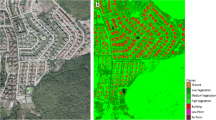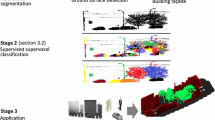Abstract
LIDAR (LIght Detection And Ranging) data are a primary data source for digital terrain model (DTM) generation and 3D city models. This paper presents a three-stage framework for a robust automatic classification of raw LIDAR data as buildings, ground and vegetation, followed by a reconstruction of 3D models of the buildings. In the first stage the raw data are filtered and interpolated over a grid. In the second stage, first a double raw data segmentation is performed and then geometric and topological relationships among regions resulting from segmentation are computed and stored in a knowledge base. In the third stage, a rule-based scheme is applied for the classification of the regions. Finally, polyhedral building models are reconstructed by analysing the topology of building outlines, building roof slopes and eaves lines. Results obtained on data sets with different ground point density, gathered over the town of Pavia (Italy) with Toposys and Optech airborne laser scanning systems, are shown to illustrate the effectiveness of the proposed approach.















Similar content being viewed by others
References
Weibel R, Heller M (1991) Digital terrain modelling. In: Maguire DJ et al (eds) Geographical information systems—principles and applications. Longman, London, pp 269–297
Shiode N (2001) 3D urban models: recent developments in the digital modelling of urban environment in three-dimensions. GeoJournal 52(3):263–269
Baltsavias EP (1999) Airborne laser scanning: existing systems and firms and other resources. ISPRS J Photogramm Remote Sens 54:164–198
Ledermann W (1980) Kalman filtering. Handbook of applicable mathematics, statistics, vol IV. Emlyn Lloyd, New York
Kilian J, Haala N, Englich M (1996) Capture and evaluation of airborne laser scanner data. Int Arch Photogramm Remote Sens Spat Inf Sci 31(3):383–388
Vosselman G, Maas H-G (2001) Adjustment and filtering of raw laser altimetry data. OEEPE Official Publ 40:62–72
Burman H (2002) Laser strip adjustment for data calibration and verification. Int Arch Photogramm Remote Sens Spat Inf Sci 34(3A):67–72
Noronha S, Nevatia R (2001) Detection and modeling of buildings from multiple aerial images. IEEE Trans Pattern Anal Mach Intell 23(5):501–518
Kraus K, Pfeifer N (1998) Determination of terrain models in wooded areas with airborne laser scanner data. ISPRS J Photogramm Remote Sens 53(4):193–203
Rottensteiner F, Briese C (2002) A new method for building extraction in urban areas from high-resolution LIDAR data. Int Arch Photogramm Remote Sens Spat Inf Sci 34(3A):295–301
Axelsson P (2000) DEM generation form laser scanner data using adaptive TIN models. Int Arch Photogramm Remote Sens Spat Inf Sci 33(B4/1):110–117
Brovelli MA, Cannata M, Longoni UM (2002) Managing and processing LIDAR data within GRASS. http://www.ing.unitn.it/~grass/conferences/GRASS2002/proceedings/proceedings/papers_by_author.html (accessed 4 April 2004). Also in Proceedings of open source GIS—GRASS user’s conference, Trento, Italy
Filin S (2002) Surface clustering from airborne laser scanning data. Int Arch Photogramm Remote Sens Spat Inf Sci 34(3A):119–124
Roggero M (2002) Object segmentation with region growing and principal component analysis. Int Arch Photogramm Remote Sens Spat Inf Sci 34(3A):289–294
Foerstner W (1999) 3D-city models: automatic and semiautomatic acquisition methods. In: Fritsch D, Spiller R (eds) Photogrammetric week ‘99. Wichmann Verlag, Heidelberg, pp 291–303
Guelch E, Mueller H, Läbe T (1999) Integration of automatic processes into semi-automatic building extraction. Int Arch Photogramm Remote Sens Spat Inf Sci 32(3-2W5):177–186
Guelch E (2000) Digital systems for automated cartographic feature extraction. Int Arch Photogramm Remote Sens Spat Inf Sci 33(B29):241–256
Haala N, Brenner C (1997) Interpretation of urban surface models using 2D building information. In: Gruen A, Baltsavias E, Henricsson O (eds) Automatic extraction of man-made objects from aerial and space images (II). Birkhauser Verlag, Basel, pp 213–222
Haala N (1999) Combining multiple data sources for urban data acquisition. In: Fritsch D, Spiller R (eds) Photogrammetric week ‘99. Wichmann Verlag, Heidelberg, pp 329–339
Brenner C (2000) Towards fully automatic generation of city models. Int Arch Photogramm Remote Sens Spat Inf Sci 33(3):85–92
Fischler MA, Bolles RC (1981) Random sample consensus: a paradigm for model fitting with applications to image analysis and automated cartography. Commun ACM 24(6):381–395
Weidner U, Foerstner W (1995) Towards automatic building extraction from high resolution digital elevation models. ISPRS J Photogramm Remote Sens 50(4):38–49
Weidner U (1997) Digital surface models for building extraction. In: Gruen A, Baltsavias E, Henricsson O (eds) Automatic extraction of man-made objects from aerial and space images (II). Birkhauser Verlag, Basel, pp 193–202
Hoover A, Jean-Baptiste G, Jiang X, Flynn PJ, Bunke H, Goldgof DB, Bowyer K, Eggert DW, Fitzgibbon A, Fisher RB (1996) An experimental comparison of range image segmentation algorithms. IEEE Trans Pattern Anal Mach Intell 18(7):673–689
ISPRS (2003) ISPRS test on extracting DEMs from point clouds: a comparison of existing automatic filters. http://www.enterprise.lr.tudelft.nl/frs/isprs/filtertest/ (accessed 4 April 2005)
Nardinocchi C, Forlani G (2001) Detection and segmentation of building roofs from Lidar data. In: Proceedings of ISPRS workshop on 3D digital imaging and modelling applications of heritage, industries, medicine & commercial land, Padua, Italy
http://www.toposys.com/ (accessed 4 April 2005)
http://www.optech.ca/ (accessed 4 April 2005)
Acknowledgments
This work has been partly financed under the Italian national research project COFIN no. 9808229941_002.
Author information
Authors and Affiliations
Corresponding author
Rights and permissions
About this article
Cite this article
Forlani, G., Nardinocchi, C., Scaioni, M. et al. Complete classification of raw LIDAR data and 3D reconstruction of buildings. Pattern Anal Applic 8, 357–374 (2006). https://doi.org/10.1007/s10044-005-0018-2
Received:
Accepted:
Published:
Issue Date:
DOI: https://doi.org/10.1007/s10044-005-0018-2




